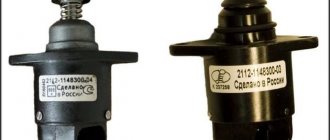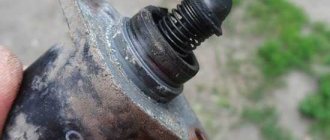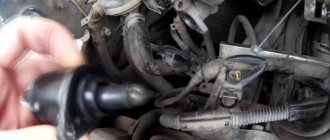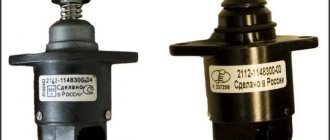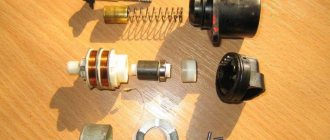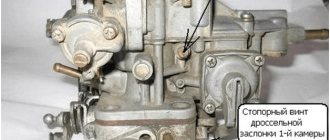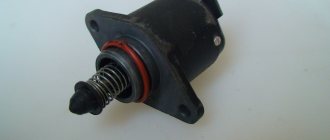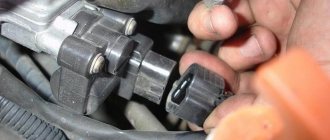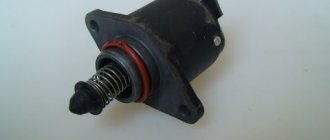A faulty idle speed controller leads to various engine malfunctions. One of them is when the engine stalls when the speed is reduced, which is fraught with an emergency situation. How to determine the malfunction of the IAC and replace it in the article.
Drivers often call the IAC sensor an idle speed sensor, which is completely wrong. The sensor “takes” readings and displays them on the screen (or device), and the regulator directly controls the operation of the engine. However, he is a sinner and I often call him that out of habit.
Typically, injection sevens have an IAC with article number 2112-1148300-04 (the last digit is the IAC version).
The idle speed sensor is installed on the injection VAZ 2107 in the lower part of the throttle valve on the right. You won't be able to replace it with a new one without removing it, but you will have to disassemble it a little. But more on that below, but first let’s look at the signs of a malfunction. Although I note that it is still possible not to remove the damper if you have a special screwdriver.
Features for injector and carburetor
The idle speed regulator (sensor) belongs to the fuel system of an internal combustion engine with distributed injection. The purpose of the part is to open the air pipe into the receiver when the throttle valve is closed within strictly defined limits.
Structurally, the IAC on the VAZ 2107 is an electric motor, which consists of a stator, a magnetic rotor and a spring-loaded rod mechanism with a locking tip. The ECU sensor controls the opening of the damper to a certain area.
For carburetor engines, a different solenoid valve operation scheme is used. The regulator is installed in the carburetor; it is based on an electromagnet with a locking part. When voltage is applied from the ECU, the valve releases passage in the fuel nozzle.
Tools and equipment for work
To carry out maintenance work you will need:
- A set of standard keys;
- Screwdrivers;
- Pliers;
- Rags;
- Carburetor cleaner (“Carb Cleaner” or equivalent);
You will also need a repair kit for the carburetor. Various types of repair kits are available, some of which include only gaskets, while others include all parts (jets, screws, emulsion tubes, etc.). It is better to purchase a complete set.
Since the carburetor consists of many small parts, disassembling it into its component parts, washing and troubleshooting and tuning is carried out in stages so as not to lose sight of anything.
The principle of operation of the carburetor is simple. Its task is based on creating an air-fuel mixture, mixing air and fuel in the required proportions, after which this mixture enters the combustion chamber, where it is ignited. The “Seven” carburetor includes the following devices that ensure distribution of the fuel mixture:
- XX engine support.
- Acceleration pump.
- Maintain a stable fuel level.
- Econostat system.
- Support for starting and warming up the internal combustion engine.
- The main metering chamber, where there are air and fuel jets, a diffuser, a well, a VTS sprayer, and an emulsion tube.
After adjustment, noise and vibration decreased significantly. The engine runs smoothly and starts quickly. The power has increased and it picks up speed better. Fuel consumption has noticeably decreased.
Location of the sensor on the VAZ 2107
In injection engines, the sensor is located on the intake manifold in the throttle block.
In carburetor engines, the control solenoid valve is located in the unit block.
Remaking the carburetor and disabling the EPH — Lada 2107, 1.6 l., 2004 on DRIVE2
Good day everyone! Today I encountered the problem of no idle speed (idle speed) on my 7, when the engine was warm and the choke was released, the car simply stalled, and with the choke extended, the revolutions fluctuated! Just recently I watched a video on the Internet about the operation of the EPXX system! And at the end of this video there is a very interesting modification to bypass this very system!
Original carburetor DAAZ 2107 1107010
carburetor DAAZ 2107 1107010-20
Find 2 differences))) I decided to redo it so that in the future I won’t bother with this system anymore!
For this purpose we purchased:
1. Solenoid valve 100 rub.
Solenoid valve
2. Economizer 50 rub.
Economizer
We unscrew the economizer together with the mic from the carburetor, screw in the purchased one instead, we also unscrew the idle jet and screw in the solenoid valve and connect it with the orange wire that was connected to the mic! Then we adjust the XX speed, and that’s it) Instead of DAAZ 2107 1107010 it turned out to be 1107010-20) I also replaced the spark plugs and installed Denso again)))
candles)
Photos from the Internet, I didn’t film the work process! Good luck to everyone) Bonus is the same video about EPHH
Issue price: 490 ₽
Signs of breakdown
Problems with engine operation during idling are not always associated with a malfunction of the fuel system. For carburetor engines that use a classic ignition circuit, a jumping stroke in 70% of cases is associated with a broken group of contacts and incorrect carburetor settings.
The carburetor magnetic valve operates only when the ignition is on. Therefore, before repairing a part, the quality of the power supply to the central wire of the carburetor and the integrity of the circuit are checked. Causes of unstable engine idle speed:
- The carburetor is clogged with dirt.
- The winding in the IAC has burned out.
- Clogged jets, fuel or air filter.
- Incorrect carburetor setting.
The first signs that the IAC has burned out on an engine with a distributed injection system:
- Unstable operation of the internal combustion engine (stalls if the accelerator is released, troits).
- The revolutions float (decrease or increase).
- The engine power decreases and a difficult start is felt.
If the regulator is burnt out, the engine computer signal system does not display the CHECK error on the instrument panel, so the part is diagnosed based on the symptoms when checking the system.
Preparing the machine
The preparation operations are not complicated and standard for any repair, but your personal safety, the time spent on maintenance and repair, as well as the quality of the work largely depend on their implementation. We prepare our VAZ2107 car for replacement as follows:
- We do car washing
- If possible, it is advisable to wash the outside of the car before work (you will get less dirty while working), including the bottom if necessary
- If the work (as in our case) is to be done in the engine department, then it should be washed there too
- The operation associated with washing the engine compartment is best performed in a non-automated car wash.
- Here, the engine compartment of your car will be washed by hand, having previously treated the outside of the body and the engine compartment with specific cleaning compounds.
- They will also remove dirt stuck in the wheel arches, as well as from the bottom of the body, using a directed jet of water under pressure, with drying completed.
Warning: When washing the engine compartment, you should protect the pads, sensors and other actuators of the fuel injection system from getting water. You should also avoid getting water on the starter and alternator. The sensors and contacts are wrapped with insulating tape or tape, the generator and starter are covered with plastic bags and the bags are secured so that they do not fly off. In any case, washing the engine compartment involves disconnecting the terminals from the battery. After washing, the above components and parts must be thoroughly dried; to do this, blow them with a stream of compressed air.
Diagnostics of IAC electrical wiring
Before replacing or cleaning a part, check the supply circuit with a multimeter. The order of ringing the chain step by step:
- Locate the sensor wires in the electrical cable block.
- Disconnect the block, turn on the ignition.
- Switch the multimeter to voltmeter mode, connect the minus probe to ground (car body).
- Plus, alternately apply “A” and “D” to the output.
If the voltage is similar to the parameters of the on-board electrical network (approx. 12 V), the supply circuit is in order. If the voltage is less than 10 V or there is no voltage at all, check the car's wiring.
Jets and accelerator pump
A nozzle (injector) is a device for supplying fuel in a certain amount. The engine draws in air through the opening of a large diffuser. At the same time, fuel is dosed through the nozzle. The amount of air sucked in through the diffuser, as well as the amount of gasoline drawn in, depends on the engine displacement. Because of this, on engines with large volumes, carburetors with small jets are installed.
In order for the jet to produce a normal fuel assembly, not lean, it is necessary to find a carburetor that was initially designed for a certain engine volume or as close as possible to it. First, select the fuel and then the air jet. They are selected for the first camera, then the second camera is configured.
The accelerator pump is necessary to supply additional fuel when the throttle is opened, this provides more efficient acceleration. The pump operates through a special cam mechanism. On engines with Solex, you need to install the largest possible cam for the accelerator pump.
Replacement
Diagnostics, cleaning and replacement of the throttle body is carried out after removing the throttle unit from the car.
The sensor is carefully removed from the dismantled unit and inspected. To check the performance of the dhx, use a tester switched to ohmmeter mode. Step by step diagnostic procedure:
- Set the measuring range on the tester to 0-200 Ohm.
- Attach the probes to the terminals, first on “A” and “B”, then “C” and “D”. The working element will show a value within the range of 50-53 Ohms.
- Take measurements between opposite pairs: “A” and “C”, then “B” and “D”. On a working unit, the instrument readings should tend to infinity.
If the electrical parameters are normal, the rod is measured - the overhang length should not exceed 22 mm.
If the rod is jammed, its size is increased, there are no optimal indicators of the multimeter, the part is changed. It is not advisable to repair the sensor.
Disassembling and cleaning the unit
The tools for disassembling the carburetor will be the same as for dismantling. We perform the procedure in the following order:
- Place the product on a clean surface, unscrew the fasteners of the top cover and remove it.
| Carburetor designation | Fuel main system | Air main system | Fuel idle | Air idle | Accelerator pump nozzle | |||||
| I Kam. | II Kam. | I Kam. | II Kam. | I Kam. | II Kam. | I Kam. | II Kam. | fuel | bypass | |
| 2107–1107010; 2107–1107010–20 | 112 | 150 | 150 | 150 | 50 | 60 | 170 | 70 | 40 | 40 |
| 2107–1107010–10 | 125 | 150 | 190 | 150 | 50 | 60 | 170 | 70 | 40 | 40 |
To clean the float chamber from dirt, you need to use a medical bulb. It is used to collect remaining fuel and debris at the bottom. It is not recommended to use rags, as lint can get into the jets and clog them.
The most common way to remove contaminants from inside a product involves disassembling it piece by piece, which not every car enthusiast can do. There is also a simpler option for cleaning the unit without disassembling it using special aerosols. The most popular are ABRO and Mannol.
Washing is carried out as follows:
- With the engine turned off and cooled down, dismantle the air filter housing and unscrew the solenoid valve.
Before you start repairing or adjusting the carburetor, you need to be sure that it is the problem. In addition, the unit must be periodically inspected and cleaned of contaminants that form both outside and inside the mechanism, which step-by-step instructions will help you with.
Features of tuning carburetor engines
In the VAZ 2107 engine, the carburetor uses an undistributed fuel mixture supply circuit, there is no idle speed sensor as such in the system, the operation of the entire solenoid valve block is checked: jets, spring-loaded mechanism and power quality.
Malfunctions can be eliminated by flushing the carburetor, cleaning the jets and channels. It remains mandatory to adjust the fuel level in the float chamber and check the jets for compliance with the markings, since the parts have different sizes.
Description of models
The first VAZ 2107 was standardly equipped with a DAAZ carburetor In Russia, they were modified to meet the needs of the local automobile industry. DAAZ products had simple assembly, which subsequently affected their price. The given carburetor model was characterized by maximum simplicity and made it possible to provide good acceleration characteristics to the car. Initially, the space in the engine compartment was created specifically for DAAZ.
The VAZ 2107 carburetor is a complex, high-precision device, consisting of two chambers, one of which - the first is equipped with a special mechanical damper drive. It can be installed on any domestic rear-wheel drive car. The volume of the model in question is 1.5 and 1.6 liters.
Gasoline consumption when using DAAZ increases noticeably. But this is consistent with the car’s speed indicators, which are also increasing. And this is especially important when overtaking.
Drawing our attention to the model - “Ozone” - it is worth noting that this is a more modified version of the standard DAAZ. The new optimized mechanism had better environmental performance. Thanks to this, “Ozone” received its environmentally friendly name. In addition, it consumed much less fuel than the previous version, so for such an economical car as the VAZ 2107, the Ozone carburetor was considered the most optimal option of all possible.
Replacing the idle speed regulator VAZ 2107 (injector)
A faulty idle speed controller leads to various engine malfunctions. One of them is when the engine stalls when the speed is reduced, which is fraught with an emergency situation. How to determine the malfunction of the IAC and replace it in the article.
Drivers often call the IAC sensor an idle speed sensor, which is completely wrong. The sensor “takes” readings and displays them on the screen (or device), and the regulator directly controls the operation of the engine. However, he is a sinner and I often call him that out of habit.
Typically, injection sevens have an IAC with article number 2112-1148300-04 (the last digit is the IAC version).
The idle speed sensor is installed on the injection VAZ 2107 in the lower part of the throttle valve on the right. You won't be able to replace it with a new one without removing it, but you will have to disassemble it a little. But more on that below, but first let’s look at the signs of a malfunction. Although I note that it is still possible not to remove the damper if you have a special screwdriver.
Why is the engine speed unstable?
When it comes to the carburetor, there are several reasons:
- The carburetor is clogged, the movement of air and gasoline becomes impossible.
- The operation of the solenoid valve is disrupted - the winding is burned out or the nozzle is clogged.
- Fuel or air filters are clogged.
- Incorrect carburetor adjustments on VAZ 2107.
In most cases, the culprit is the solenoid valve. Its appearance is shown in the photo. It is necessary in the power system for the following purpose - it opens the fuel supply when the ignition is turned on and closes it when it is turned off. Consequently, the engine stops immediately after turning off the ignition.
The VAZ 2107 carburetor solenoid valve is a small device consisting of the following elements:
- Frame.
- Winding (one end connected to a metal body).
- A rod that acts as a valve that opens and closes the fuel supply at idle.
- Copper jet with holes. Please note that the jets are marked; there are several sizes.
The solenoid valve operates only when the ignition is on. If suddenly there is a break in the power circuit, you can temporarily connect the central wire of the device to the positive terminal of the battery. Just try to carry out repairs as soon as possible.
Signs of a VAZ IAC malfunction
Signs of a regulator malfunction vary, here are the main ones:
- the engine stalls when the gas pedal is released;
- poor engine starting;
- floating engine speed;
- increased speed.
It should be borne in mind that some symptoms of a broken IAC may coincide with a malfunction of other sensors: crankshaft position, throttle valve or mass air flow. Therefore, you can accurately determine its malfunction by taking some measurements yourself or using computer diagnostics.
How to install the unit in place
You can assemble and reinstall the carburetor in the same way as you disassembled it, performing all the steps in reverse order.
- The carburetor is installed in its place, the mounting bolts are tightened.
- The pipes through which fuel is supplied are attached. The gas cable is connected to the throttle lever.
- The wiring is attached.
- A vacuum hose is connected to the ignition distributor, and the EPHH limit switches are combined.
- After installing the carburetor, it is adjusted.
How to check the XX regulator
Self-checking the serviceability of the IAC VAZ 2107 and other models consists of measuring the voltage at the connection block, checking the resistance between the sensor terminals and measuring the length of the rod.
The figure below shows a drawing of the idle air control device. I am citing it to better understand the necessary checks.
VAZ idle speed control device
As you can see, there are 2 windings on the sensor. This is a stepper motor, one winding of which extends the rod, the second winding retracts it. A break in these windings, a short circuit between turns or even windings indicates a malfunction.
The regulator cannot be repaired and if a malfunction is detected, it must be replaced.
To check the regulator, you need a multimeter and a caliper (or ruler).
- First you need to disconnect the block and turn on the ignition and check for voltage at terminals A and D. It should be equal to the on-board network voltage. Its absence may indicate a malfunction of the ECU or the IAC power circuit. Sometimes a resistor breaks in the ECU and no power is supplied.
- Next, switch the multimeter to resistance measurement mode and look at the resistance between windings AB and CD. It should be about 52 ohms. In other positions there should be no resistance.
- Measure the length of the extended rod, it should be 23 mm. Deviation from it also indicates a malfunction.
Procedure
To work, we need a laptop and a diagnostic cable.
Laptop
A laptop or tablet computer running a desktop version of the Windows operating system, as well as special software that is designed specifically for your car brand. Of course, you can connect a desktop computer, but then be prepared to take it outside, directly to the hood of the car.
Diagnostic cable for connection to the ECU
You will also need to purchase a cable to connect the on-board computer to the laptop. As a rule, these cables are divided into several main types, which do not differ very much from each other. Just decide which version of the connector is used in the car. In the oldest models this is the first version, and in newer ones this is the second version of the connector. The port is shaped in such a way that you will not be able to connect it incorrectly.
As soon as the connection to the on-board computer is completed, in the program running on the laptop, you can view all the parameters of the vehicle’s operation, as well as any errors that arose during the process. Error codes can be found in the documentation accompanying the program or on the Internet.
If necessary, new firmware can be installed on the on-board computer. This is done using the capabilities of the same diagnostic program.
How to replace idle air control
To replace the regulator, you can go in three ways:
- with complete disassembly of the throttle valve;
- partial;
- without removal.
I changed the regulator with complete disassembly, as I discovered clogged tubes, and a dropped plug rattled inside the receiver. When disassembling and cleaning I used carburetor cleaner. Although this is the same acetone and could have been saved.
Carburetor cleaner, if it is not needed under pressure, can be easily replaced with simple acetone
In the second option, the replacement is made without removing the tubes, but with removing the throttle. In this case, the air duct clamp is loosened, the throttle is unscrewed and, by moving it a little, removed from the studs. You need to turn it a little, this will give access to the sensor mounting bolt.
In the third option, you need a special screwdriver capable of unscrewing the sensor mounting screw. Typically, this is a flexible screwdriver for hard-to-reach places or an angled attachment for a screwdriver.
Necessary tool
To replace the sensor you will need:
- Flathead screwdriver.
- Crosshead screwdriver.
- Socket or open-end wrench size 13.
Removing the carburetor
Sometimes the carburetor needs to be removed, for example, for replacement, repair or cleaning. For such work, you need to prepare a set of tools consisting of open-end wrenches, screwdrivers and pliers. If the damage is minor, then there is no need to remove the device.
Then we perform the following sequence of actions:
- In the engine compartment, loosen the clamp on the corrugated pipe and tighten it.
Which IAC should I choose?
I can recommend IAC from two manufacturers: Kaluga and Startvolt. Samarsky staged it, but there was some luck with him, it lasted for a year, just like with “PEKAR”. So which regulator is better can be checked with sellers, since they have information on the number of returns.
When purchasing, pay attention to the presence of quality control stamps and dates. Check the rod for play and absence of rotation. The presence of Chinese counterfeits on the market is quite large.
Whether the valve should have a wide or narrow cap seems to me to make no difference. Since the main role is played by the narrow part before expansion.
How does the idle air control control work?
As you can see in the photo, the valve opens the bypass channel when the engine starts and closes it as it warms up. The narrow part of the valve is involved in the work.
Source
Important adjustment points
After the installed structural element has reached its optimal position, it is necessary to press the gas pedal: the motorist must check the functionality of the motor, which will “raise” the crankshaft speed without interruption. At the same time, there should be no sudden damping of the engine after the pedal is released. If there are negative aspects, you will have to re-adjust the carburetor.
The CO content in the exhaust gases of the power unit must also be checked; according to the rules, after such manipulations it should decrease. With ideal performance of all components, CO should fluctuate within 1.5%.
When the screws do not help normalize the speed, the car owner will have to additionally check the power unit, since such moments indicate that the fuel “goes” to the mixing chamber, bypassing the idle system. In this case, you need to pay attention to the carburetor solenoid valve to close it. At the same time, you should measure the diameter of the nozzle hole, which is sometimes larger than necessary.
Source
How to set up the idle speed sensor on a VAZ 2107 injector
There may be several reasons for this unpleasant problem:
The IAC idle speed controller is malfunctioning
The idle speed of the engine changes by itself and it may even stop; often the engine does not want to start without pressing the gas pedal. And the “Check Engine” lamp may not light up. At medium and high speeds, the engine keeps its speed evenly, and no loss of power is noticeable.
Problems with the mass air flow sensor (mass air flow sensor)
If the mass air flow sensor is faulty, the speed may change not only at idle speed, but also at any other throttle opening, even when driving under load. A car can put its owner in a very dangerous situation by suddenly losing traction while overtaking. The check engine light is usually on. If you notice these signs, you will need to replace the faulty sensor. Read how to do this here
Air leaks through cracks in hoses and seals
Excess air that enters the engine intake tract bypassing the mass air flow sensor depletes the combustible mixture. The speed and power of the motor changes, the controller tries to correct this. As a result, the speed and “traction” change. But unlike the case with a faulty mass air flow sensor, this does not happen so abruptly. The Check Engine light does not come on.
Carefully inspect all tubes and hoses that extend from the throttle body, gaskets, the throttle body itself, and the intake manifold for cracks. Pay special attention to the hose going to the vacuum brake booster, as it often cracks. It also happens that the vacuum booster itself begins to “poison” the air and then when you press the brake pedal, the engine speed will change. Eliminate all these faults and the engine will start running smoothly again.
Other reasons
A car is a very complex system and it is simply impossible to describe the incredible variety of possible combinations of breakdowns. The engine may “jerk” when driving and change speed due to a malfunction of the ignition system, injectors, bad gasoline, water getting into the tank, dirty filters, etc. In each specific case, you need to carefully analyze all the signs and draw conclusions. If all else fails, you can always undergo verification diagnostics with a motor tester.
Air leak
It is one of the most difficult problems and can be caused by several reasons:
- Crooked seat
- Gasket failure
- Throttle valve not closed
To make sure that this problem exists, you need to check the color of the spark plugs and the number of idle speeds. If the speed is too high and the spark plugs have a white coating, then the mixture is lean, which means more air is coming in than it should be.
In this case, the check begins by treating the carburetor-manifold joints with a throttle valve cleaner. Start processing from the intake manifold, then move to the junction of the carburetor and manifold and complete the EPH. A change in the speed will indicate the presence of air leaks. It should be located at the joints of the gaskets.

